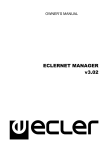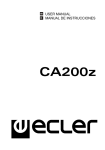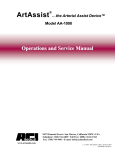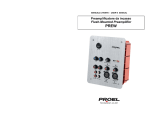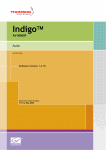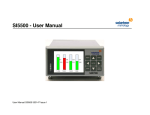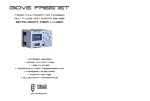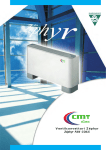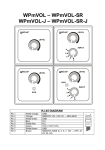Download CA-NETRS-232 Remote Control Protocol
Transcript
CA‐NET Protocol ENGLISH VERSION CA‐NET RS‐232 Remote Control Protocol NOV 2012 The built‐in RS‐232 port in the rear panel of the CA series amplifiers allows for an external device communication via a serial connection. This kind of connection uses a syntax which is very similar to the one used in the Ecler TP‐NET protocol: it lets a client device get from and/or set the values of several parameters of a CA device (for instance, the CA40 or CA200z digital amplifiers), like volumes, mutes, equalisation tones, etc. The RS‐232 serial communication must fulfil the following specifications: Baud rate: 9600 (fixed, no auto‐negotiation) Data bits: 8 Parity: None Stop bits: 1 Flow control: None It’s not allowed to have more than one simultaneous access from several clients to the same CA device using the RS232 connection. The protocol is simple and direct, syntax‐friendly, making it easy to read, write and modify the generated code. It is based on messages with no begin delimiter: each message is self‐delimited by the RS232 packet size, which is defined with a maximum of 80 ASCII characters, and always including the character LF (0x0A) at the end of each message. All the messages must be written in CAPITAL LETTERS. To let some control systems (like EXTRON®, CRESTRON®, AMX®, RTI®, VITY®, MEDIALON®, etc.) process the messages more easily, the CA device adds the character LF (0x0A) at the end of each message it sends. This way the client of the CA device can buffer the received messages to process them, when required. The CA device can also handle several messages received in a single RS232 packet by using the LF delimiter. The available messages are built with one or more fields separated with blank spaces ( = blank space): <TYPE> [PARAM1] [PARAM2] [PARAM3] [PARAM4][LF] The first field (TYPE) defines the message type and then, the required parameters for it (each kind of message requires a given number of parameters). The field TYPE can have these values: GET page 1 / 21 CA‐NET Protocol SET DATA ERROR At the end of this document you’ll find a table including all the available messages and their parameters for each model of CA compatible device. The GET & SET messages can be sent from the client to the CA device. The DATA & ERROR messages can be sent from the CA device to the client. The SET messages coming from a client device don’t have an automatic acknowledgement with a DATA message sent from the CA device after it has processed the SET command. The client must update the values itself, sending the needed GET message to ask for a parameter’s value when it requires confirmation from the device. On the other hand, when a local control in the CA unit occurs (front panel controls or infrared remote control), the CA device will automatically send the associated DATA command via its RS‐232 interface. A couple of special parameters for the GET and SET commands would require a detailed explanation: AUTOLOAD_PRESET1: its value (ON/OFF) defines whether preset number 1 must be recalled or not each time the CA device is powered ON, defining this way the default working mode at startup PANEL_LOCKED: its value (ON/OFF) defines whether the front panel controls (the rotary encoder in the case of the CA40, and the encoder and the function keys in the case of the CA200z) is enabled (PANEL_LOCKED=OFF) or disabled (PANEL_LOCKED=ON) for local management of the device. (see the CA40 or CA200z user manual for further details) NOTES: The numerical values are always integer numbers without comma or dot symbols <Input Name> are text strings (without blank spaces) that identify an audio input of the CA device. For the CA40, there are 5 possible Input Names: o LINE1 o LINE2 page 2 / 21 CA‐NET Protocol o MICRO o LINE1_AND_MICRO o LINE2_AND_MICRO And 6 in the case of the CA200z: o LINE1 o LINE2 o LINE2 o LINE4 o MICRO1 o MICRO2 <Preset Number> is a numerical value that identifies one available Preset stored in the device’s memory. It can be within the [1..5] range. <Volume Level> are numerical values in the [0…64] range that define values in a scale equivalent to [‐inf...Maximum_Volume] in 1.25 dB steps. <Tone Level> are numerical values in the [‐10…10] range that define values in a scale equivalent to [‐10, ‐8, ‐6, ‐4, ‐2, 0, 2, 4, 6, 8, 10] dB. If the numerical value is not in this list, the unit will reply with an error message. <Increment Value> are numerical values in the [0…64] range that define a value in a scale equivalent to [Increment Value]x(1.25) dB, used to increase or decrease the current absolute value of a level. <Threshold Level> the allowed numerical values in this field are just 3 [20, 25, 30]. It defines a value in a scale equivalent to [20, 25, 30] dB below the nominal level value for a given audio input. If the numerical value is not in this list, the unit will reply with an error message. <Depth Level> the allowed numerical values in this field are just 4 [20, 30, 60, 80]. It defines a value in a scale equivalent to [20, 30, 60, 80] dB. If the numerical value is not in this list, the unit will reply with an error message. page 3 / 21 CA‐NET Protocol <Attack Time Value> the allowed numerical values in this field are just 4 [50, 100, 200, 300]. It defines a value in a scale equivalent to [50, 100, 200, 300] milliseconds. If the numerical value is not in this list, the unit will reply with an error message. <Release Time Value> the allowed numerical values in this field are just 5 [300, 500, 1000, 2000, 3000]. It defines a value in a scale equivalent to [300, 500, 1000, 2000, 3000] milliseconds. If the numerical value is not in this list, the unit will reply with an error message. <Remote Select Value> are text strings (without blank spaces) that identify the function of the analogue (0 – 10 VDC) remote control selector connected to a physical “REMOTE” port in the device. In the case of the CA40, there are just two possible string values for this parameter: o INPUTS o PRESETS And three in the case of the CA200z: o OFF o INPUTS o PRESETS Note: In the CA40, a single REMOTE port admits the connection of a WPmVOL‐SR unit, which has a volume control knob and a 5‐position rotary switch, or selector. The selector can be used in any of these two modes: o INPUTS: to select the active audio source(s) (LINE1, LINE2, MICRO, LINE1_AND_MICRO or LINE2_AND_MICRO) o PRESETS: to recall any of the 5 presets in the memory of the unit, which store the full configuration of the unit, including volumes, EQ, etc. The factory default working mode of the selector is INPUTS, and it can just be modified to PRESETS by means of an RS‐232 connection. page 4 / 21 CA‐NET Protocol In the CA200z there are two independent REMOTE ports, each one able to control one of the device’s outputs when the CA200z has been configured in the ZONES A/B mode. Each selector can be used in any of these 3 modes: o INPUTS: to select the active audio LINE source (OFF, LINE1, LINE2, LINE3 or LINE4) o PRESETS: to recall any of the 5 presets in the memory of the unit, which store the full configuration of the unit, including volumes, EQ, etc. Just one out of these two remote ports can be configured to recall presets, not both at the same time o OFF: REMOTE port disabled. <Zone> are text strings (without blank spaces) that identify a zone where the command will operate. In the CA200Z there are just two possible values for this parameter: o ZA (output labeled as ZA or L) o ZB (output labeled as ZB or R) When the <Zone> parameter is not specified, the CA200z will understand the command will operate over ZA. <Micro Name> are text strings (without blank spaces) that identify the MIC inputs in the unit. In the CA200Z there are just two possible values for this parameter: o MICRO1 o MICRO2 <Output Mode> are text strings (without blank spaces) that identify the amplifier’s output working mode. In the CA200Z there are just four possible values for this parameter: o STEREO o MONO o BRIDGE o ZONES <Zone Label> is a text string that contains the customized name for a zone that the CA200z will show in its LCD display. The maximum length for this string is 17 characters, being ignored those exceeding this limit. Blank characters are not allowed. A valid example: MAIN_HALL page 5 / 21 CA‐NET Protocol <Display Mode> are text strings (without blank spaces) that identify the LCD display working mode. In the CA200Z there are just three possible values for this parameter: o ON o DIMMED o OFF <Contrast Level> are numerical values in the [0…100] range that define the LCD display contrast level. <Assign Value> are text strings (without blank spaces) that identify the Talkover / Pager function assignment for a MIC input towards the device’s outputs. In the CA200Z there are just five possible values for this parameter:: o OFF o ZA o ZB o ZA‐B o PAGER <Priority> is a numerical value that defines the Talkover function priority of one MIC input in front of the other inputs in the unit. In the case of the CA200z just two values are valid [1, 2], being “1” the highest priority level and “2” the lower one. <Error ID> is a numerical value for an error code. “<Error Description>” is a text chain inside double quotation marks, containing an error description. page 6 / 21 CA‐NET Protocol SPANISH VERSION CA‐NET RS‐232. Protocolo de Control Remoto NOV 2012 El puerto RS‐232 integrado en la serie de amplificadores CA permite a un dispositivo externo establecer comunicación serie empleando para ello el protocolo CA‐NET. Dicho protocolo emplea una sintaxis muy similar a la del protocolo TP‐NET, y permite a un dispositivo externo obtener y/o modificar el valor de ciertos parámetros del permite a un equipo cliente consultar y modificar diversos parámetros del amplificador (por ejemplo, del CA40 o CA200z), como volúmenes, función MUTE, ecualización, etc. La comunicación RS‐232 debe cumplir con las siguientes especificaciones: Baud rate: 9600 (fijo, sin autonegociación) Data bits: 8 Parity: No Stop bits: 1 Flow control: No No está permitido mediante la conexión RS‐232 más de un acceso simultáneo, desde varios dispositivos externos, al mismo dispositivo CA. El protocolo es simple y textual, facilitando así la lectura, escritura de código y modificación, y está basado en mensajes, sin necesidad de delimitador de inicio: cada mensaje viene delimitado de forma implícita por el tamaño del paquete RS‐232, con un tamaño máximo de mensaje de 80 caracteres ASCII, siempre incluyendo el carácter LF (0x0A) al final de cada mensaje. Todos los textos deben estar escritos en letras mayúsculas. Para facilitar el procesamiento de los mensajes en sistemas de control tipo EXTRON®, CRESTRON®, AMX®, RTI®, VITY®, MEDIALON®, etc., el dispositivo CA añade el carácter LF (0x0A) al final de cada mensaje que envía. De esta forma, si al programa cliente no le da tiempo a procesar los mensajes recibidos de uno en uno, puede concatenar varios mensajes consecutivos en una única cadena de memoria (buffer) para posteriormente volver a separarlos usando el delimitador LF. De igual forma, el dispositivo permite interpretar varios mensajes recibidos en un solo paquete RS‐232 usando el citado delimitador. Los mensajes están formados por uno o varios campos, todos ellos separados por espacios en blanco ( = espacio en blanco): <TYPE> [PARAM1] [PARAM2] [PARAM3] [PARAM4][LF] page 7 / 21 CA‐NET Protocol El primer campo (TYPE) define el tipo de mensaje, y por tanto el número de parámetros requeridos a continuación (cada tipo de mensaje requiere de un determinado número de parámetros). El campo TYPE puede tener los siguientes valores: GET SET DATA ERROR En las tablas del final del documento se describen los distintos tipos de mensajes que admite cada dispositivo CA y sus correspondientes parámetros asociados. Los mensajes tipo GET o SET son los que pueden ser enviados del cliente al dispositivo CA, mientras que los mensajes DATA y ERROR son los enviados del dispositivo CA al cliente. Los mensajes del tipo SET enviados por el cliente no tienen realimentación, es decir, el dispositivo CA no envía el mensaje DATA correspondiente tras procesar el mensaje SET. Es responsabilidad del cliente actualizar el valor internamente con el dato enviado al dispositivo y, en caso de ser necesario, emplear el mensaje GET correspondiente para verificar que el parámetro fue correctamente procesado en el dispositivo. Por el contrario, cuando se produce cualquier control local realizado en el dispositivo CA, bien desde el panel frontal del propio dispositivo, bien desde el control a distancia por infrarrojos, el dispositivo CA envía de forma automática el comanda DATA asociado mediante su interfaz RS‐232. Existen dos parámetros de los comandos GET y SET cuyas funciones conviene precisar: AUTOLOAD_PRESET1: su valor (ON/OFF) determina si el “preset” número 1 debe ser recuperado cada vez que el equipo sea puesto en marcha, determinando así sus condiciones iniciales de trabajo PANEL_LOCKED: su valor (ON/OFF) determina si el panel de control del frontal del equipo (el control giratorio digital en el caso del CA40 y el control giratorio más las teclas de función en el caso del CA200z) se encuentra habilitado (PANEL_LOCKED=OFF) o inhabilitado (PANEL_LOCKED=ON) para su manipulación. (vea el manual de usuario del CA40 ó CA200z para más detalles) NOTAS: Los valores numéricos son siempre números enteros sin signo (números positivos sin decimales) page 8 / 21 CA‐NET Protocol <Input Name> son cadenas de texto que identifican el canal de entrada de audio (o combinación de canales de entrada) activo en el dispositivo CA. En el caso del CA40, existen únicamente 5 posibles valores: o LINE1 o LINE2 o MICRO o LINE1_AND_MICRO o LINE2_AND_MICRO En el caso del CA200z, existen únicamente 6 posibles valores: o LINE1 o LINE2 o LINE2 o LINE4 o MICRO1 o MICRO2 <Preset Number> es un valor numérico que identifica uno de los distintos Preset disponibles en la memoria del dispositivo CA. Este valor puede estar en el rango [1..5]. <Volume Level> son valores numéricos en el rango [0..64] que definen valores en una escala equivalente a [‐inf...Volumen_Máximo] en incrementos de 1.25 dB. <Tone Level> son valores numéricos en el rango [‐10…10] que definen valores en una escala equivalente a [‐10, ‐8, ‐6, ‐4, ‐2, 0, 2, 4, 6, 8, 10] dB. Si el valor numérico usado no se encuentra en esta lista, la unidad responderá con un mensaje de error. <Increment Value> son valores numéricos en el rango [0…64] que definen valores en una escala equivalente a [Increment Value]x(1.25) dB, empleados para incrementar o decrementar el valor absoluto actual de un nivel. page 9 / 21 CA‐NET Protocol <Threshold Level> los únicos valores admisibles en este campo son 3 [20, 25, 30]. Define valores en una escala equivalente a [20, 25, 30] dB por debajo del nivel nominal de una entrada de audio determinada. Si el valor numérico usado no se encuentra en esta lista, la unidad responderá con un mensaje de error. <Depth Level> los únicos valores admisibles en este campo son 4 [20, 30, 60, 80]. Define valores en una escala equivalente a [20, 30, 60, 80] dB. Si el valor numérico usado no se encuentra en esta lista, la unidad responderá con un mensaje de error. <Attack Time Value> los únicos valores admisibles en este campo son 4 [50, 100, 200, 300]. Define valores en una escala equivalente a [50, 100, 200, 300] milisegundos. Si el valor numérico usado no se encuentra en esta lista, la unidad responderá con un mensaje de error. <Release Time Value> los únicos valores admisibles en este campo son 5 [300, 500, 1000, 2000, 3000]. Define valores en una escala equivalente a [300, 500, 1000, 2000, 3000] milisegundos. Si el valor numérico usado no se encuentra en esta lista, la unidad responderá con un mensaje de error. <Remote Select Value> son cadenas de texto que identifican el modo de trabajo del selector analógico (0‐ 10 VDC) conectado a un puerto “REMOTE” del dispositivo CA. En el caso del CA40 existen únicamente dos posibles valores para este parámetro: o INPUTS o PRESETS En el caso del CA200Z existen únicamente tres posibles valores para este parámetro: o OFF o INPUTS o PRESETS Nota: En el CA40 el único puerto REMOTE disponible admite la conexión de una unidad tipo WPmVOL‐SR, la cual incluye un control giratorio de volumen y un conmutador rotatorio de 5 posiciones, o selector. El selector puede usarse en uno de estos dos modos: page 10 / 21 CA‐NET Protocol o INPUTS: para seleccionar la fuente(s) de audio activa(s) (LINE1, LINE2, MICRO, LINE1_AND_MICRO ó LINE2_AND_MICRO) o PRESETS: para recuperar uno de los 5 “presets” almacenados en la memoria de la unidad (cada preset contiene la configuración completa de la unidad CA40, incluyendo volúmenes, ecualización, etc.) El modo de trabajo por defecto (de fábrica) del selector es INPUTS, y únicamente puede ser cambiado al modo PRESETS mediante una conexión RS‐232, y empleando los comandos del presente protocolo. En el CA200z existen dos puertos REMOTE independientes, cada uno de ellos con la capacidad de controlar una de las salidas del equipo cuando éste se encuentra en el modo de trabajo ZONES A/B. Cada selector puede usarse en uno de estos dos modos: o INPUTS: para seleccionar la fuente de audio LINE activa para la salida asociada (OFF, LINE1, LINE2, LINE3 ó LINE4) o PRESETS: para recuperar uno de los 5 “presets” almacenados en la memoria de la unidad (cada preset contiene la configuración completa de la unidad CA200z, incluyendo volúmenes, ecualización, etc.). Sólo uno de los dos puertos REMOTE puede ser configurado para realizar una selección de presets, no ambos simultáneamente. o OFF: puerto REMOTE desactivado <Zone> son cadenas de texto que identifican la zona sobre la que opera el comando GET o SET en cuestión. En el caso del CA200Z existen únicamente dos posibles valores para este parámetro: o ZA (salida marcada como ZA o L) o ZB (salida marcada como ZB o R) Si no se especifica el parametro <Zone> el CA200z interpreta por defecto que el comando se refiere a la ZA. <Micro Name> son cadenas de texto que identifican a las entrada de micrófono de la unidad. En el caso del CA200z existen únicamente dos posibles valores para este parámetro: o MICRO1 o MICRO2 page 11 / 21 CA‐NET Protocol <Output Mode> son cadenas de texto que identifican el modo de trabajo del amplificador. En el caso del CA200z existen únicamente cuatro posibles valores para este parámetro: o STEREO o MONO o BRIDGE o ZONES <Zone Label> es una cadena de texto que contienen el nombre personalizado de zona que será mostrado en la pantalla LCD del CA200z. La longitud máxima de dicha cadena es de 17 caracteres (siendo ignorados los que excedan ese límite), no siendo válido el carácter de espacio en blanco. Ejemplo válido: SALON_PRINCIPAL <Display Mode> son cadenas de texto que identifican el modo de trabajo de la pantalla LCD del panel frontal del equipo. En el caso del CA200Z existen únicamente tres posibles valores para este parámetro: o ON o DIMMED o OFF <Contrast Level> es un valor numérico en el rango [0..100] que determina el contraste de la pantalla LCD. <Assign Value> son cadenas de texto que identifican la asignacion de la función de Talkover / Pager de una entrada de micrófono hacia las salidas del equipo. En el caso del CA200z existen únicamente cinco posibles valores para este parámetro: o OFF o ZA o ZB o ZA‐B o PAGER <Priority> es un valor numérico que indica la prioridad de la función Talkover de una entrada frente a la prioridad de la función Talkover de otras entradas. En el caso del CA200z existen los únicos valores admisibles en este campo son 2 [1, 2]. La prioridad mayor corresponde a "1" y la menor a "2". page 12 / 21 CA‐NET Protocol <Error ID> es un valor numérico que codifica un tipo de error. “<Error Description>” es una cadena de texto encerrada entre comillas dobles que contiene una descripción del error. page 13 / 21 CA‐NET Protocol CA40 AMPLIFIER TYPE PARAM1 PARAM2 PARAM3 PARAM4 DESCRIPTION GET SET ALL PRESET_NUMBER OUTPUT_MODE INPUT MUTE MASTER_VOL LINE1_VOL LINE2_VOL MICRO_VOL LINE1_BASS LINE2_BASS MICRO_BASS LINE1_TREBLE LINE2_TREBLE MICRO_TREBLE GATE GATE_THRESHOLD TALKOVER TALKOVER_THRESHOLD TALKOVER_ATTACK TALKOVER_RELEASE TALKOVER_DEPTH REMOTE REMOTE_SELECTOR AUTO_STANDBY AUTOLOAD_PRESET1 PANEL_LOCKED INFO_MODEL INFO_VERSION LOAD_PRESET SAVE_PRESET INPUT <Preset Number> <Preset Number> <Input Name> Dumps current device status (with DATA messages) Gets the current PRESET number Gets the current amplifier OUTPUT MODE Gets the current active INPUTs Gets the current MUTE status Gets the current MASTER VOLUME Gets the current LINE1 VOLUME Gets the current LINE2 VOLUME Gets the current MICRO VOLUME Gets the current LINE1 BASS LEVEL Gets the current LINE2 BASS LEVEL Gets the current MICRO BASS LEVEL Gets the current LINE1 TREBLE LEVEL Gets the current LINE2 TREBLE LEVEL Gets the current MICRO TREBLE LEVEL Gets the current NOISE GATE ON/OFF status Gets the current NOISE GATE THRESHOLD LEVEL Gets the current TALKOVER ON/OFF status Gets the current TALKOVER THRESHOLD LEVEL Gets the current TALKOVER ATTACK TIME Gets the current TALKOVER RELEASE TIME Gets the current TALKOVER DEPTH (attenuation) Gets the current REMOTE ON/OFF status Gets de current REMOTE SELECTOR function Gets the current AUTO STANDBY ON/OFF status Gets the current AUTOLOAD_PRESET1 at Startup function Get the current PANEL_ LOCKED (front knob) status Gets the Device model name Gets the current Firmware Version Recalls and activates a PRESET Saves the current PRESET Sets the current active INPUT(s) page 14 / 21 CA‐NET Protocol DATA MUTE MASTER_VOL LINE1_VOL LINE2_VOL MICRO_VOL LINE1_BASS LINE2_BASS MICRO_BASS LINE1_TREBLE LINE2_TREBLE MICRO_TREBLE GATE_THRESHOLD TALKOVER_THRESHOLD TALKOVER_ATTACK TALKOVER_RELEASE TALKOVER_DEPTH MASTER_VOL_INC MASTER_VOL_DEC REMOTE_SELECTOR AUTOLOAD_PRESET1 PANEL_LOCKED PRESET_NUMBER PRESET_DONE ON/OFF <Volume Level> <Volume Level> <Volume Level> <Volume Level> <Tone Level> <Tone Level> <Tone Level> <Tone Level> <Tone Level> <Tone Level> <Threshold Level> <Threshold Level> <Attack Time Value> <Release Time Value> <Depth Level> <Increment Value> <Increment Value> <Remote Selector Value> ON/OFF ON/OFF <Preset Number> OUTPUT_MODE <OutputMode> INPUT MUTE MASTER_VOL LINE1_VOL LINE2_VOL MICRO_VOL LINE1_BASS LINE2_BASS MICRO_BASS LINE1_TREBLE <Input Name> ON/OFF <Volume Level> <Volume Level> <Volume Level> <Volume Level> <Tone Level> <Tone Level> <Tone Level> <Tone Level> Sets the current MUTE status Sets the current MASTER VOLUME Sets the current LINE1 VOLUME Sets the current LINE2 VOLUME Sets the current MICRO VOLUME Sets the current LINE1 BASS LEVEL Sets the current LINE2 BASS LEVEL Sets the current MICRO BASS LEVEL Sets the current LINE1 TREBLE LEVEL Sets the current LINE2 TREBLE LEVEL Sets the current MICRO TREBLE LEVEL Sets the current NOISE GATE THRESHOLD LEVEL Sets the current TALKOVER THRESHOLD LEVEL Sets the current TALKOVER ATTACK TIME Sets the current TALKOVER RELEASE TIME Sets the current TALKOVER DEPTH (attenuation) Increments the current MASTER VOLUME Decrements the current MASTER VOLUME Sets de current REMOTE SELECTOR function Sets the current AUTOLOAD_PRESET1 at Startup function Sets the current PANEL_ LOCKED (front knob) status Shows the current PRESET Shows that the last SET LOAD_PRESET n command has been processed: the preset is loaded and active Shows the current amplifier OUTPUT MODE (MONO/STEREO/BRIDGE) Shows the current active INPUT(s) Shows the current MUTE status Shows the current MASTER VOLUME Shows the current LINE1 VOLUME Shows the current LINE2 VOLUME Shows the current MICRO VOLUME Shows the current LINE1 BASS LEVEL Shows the current LINE2 BASS LEVEL Shows the current MICRO BASS LEVEL Shows the current LINE1 TREBLE LEVEL page 15 / 21 CA‐NET Protocol LINE2_TREBLE MICRO_TREBLE GATE GATE_THRESHOLD TALKOVER TALKOVER_THRESHOLD TALKOVER_ATTACK TALKOVER_RELEASE TALKOVER_DEPTH REMOTE REMOTE_SELECTOR AUTO_STANDBY AUTOLOAD_PRESET1 <Tone Level> <Tone Level> ON/OFF <Threshold Level> ON/OFF <Threshold Level> <Attack Time Value> <Release Time Value> <Depth Level> ON/OFF <Remote Selector Value> ON/OFF ON/OFF ERROR PANEL_LOCKED INFO_MODEL INFO_VERSION <Error ID> ON/OFF <Device Model> <Firmware Version> “<Error Description>” Shows the current LINE2 TREBLE LEVEL Shows the current MICRO TREBLE LEVEL Shows the current NOISE GATE ON/OFF status Shows the current NOISE GATE THRESHOLD LEVEL Shows the current TALKOVER ON/OFF status Shows the current TALKOVER THRESHOLD LEVEL Shows the current TALKOVER ATTACK TIME Shows the current TALKOVER RELEASE TIME Shows the current TALKOVER DEPTH (attenuation) Shows the current REMOTE ON/OFF status Shows de current REMOTE SELECTOR function Shows the current STANSBY ON/OFF status Shows the current AUTOLOAD_PRESET1 at Startup function Shows the current PANEL_ LOCKED (front knob) status Shows the Device Model Shows the current Firmware Version Informs about an error page 16 / 21 CA‐NET Protocol CA200z AMPLIFIER TYPE PARAM1 PARAM2 PARAM3 PARAM4 DESCRIPCIÓN GET ALL POWER PRESET_NUMBER OUTPUT_MODE ZONE_LABEL MUTE MASTER_VOL INPUT VOL BASS TREBLE GATE GATE_THRESHOLD TALKOVER_ASSIGN TALKOVER_PRIORITY TALKOVER_ THRESHOLD TALKOVER_ATTACK TALKOVER_RELEASE TALKOVER_DEPTH REMOTE_SELECTOR IR_REMOTE DISPLAY_MODE LCD_CONTRAST AUTO_STANDBY AUTOLOAD_PRESET1 PANEL_LOCKED INFO_MODEL INFO_VERSION <Zone Label> <Zone> <Zone> <Input Name> <Input Name> <Input Name> <Input Name> <Micro Name> <Micro Name> <Micro Name> <Micro Name> <Micro Name> <Micro Name> <Micro Name> <Micro Name> <Zone> <Zone> <Zone> <Zone> <Zone> <Zone> Dumps current device status (with DATA messages) Gets the current POWER status Gets the current PRESET number Gets the current amplifier OUTPUT MODE Gets the current LABEL (name) for the specified ZONE Gets the current MUTE status for the specified ZONE Gets the current MASTER VOLUME for the specified ZONE Gets the status (ON/OFF) for the specified INPUT at the specified ZONE Gets the current VOLUME for the specified INPUT at the specified ZONE Gets the current BASS LEVEL for the specified INPUT at the specified ZONE Gets the current TREBLE LEVEL for the specified INPUT at the specified ZONE Gets the current NOISE GATE status (ON or OFF) for the specified MIC INPUT Gets the current NOISE GATE THRESHOLD LEVEL for the specified MIC INPUT Gets the current TALKOVER ASSIGN for the specified MIC INPUT Gets the current TALKOVER PRIORITY for the specified MIC INPUT Gets the current TALKOVER THRESHOLD LEVEL for the specified MIC INPUT Gets the current TALKOVER ATTACK TIME for the specified MIC INPUT Gets the current TALKOVER RELEASE TIME for the specified MIC INPUT Gets the current TALKOVER DEPTH (attenuation) for the specified MIC INPUT Gets de current REMOTE SELECTOR function for the specified ZONE Gets the current IR REMOTE status (ON or OFF) Gets the current DISPLAY MODE Gets the current DISPLAY CONTRAST level Gets the current AUTO STANDBY function status (ON or OFF) Gets the current AUTOLOAD_PRESET1 at Startup function Gets the current PANEL_LOCKED (front panel controls) status Gets the Device model name Gets the current Firmware Version page 17 / 21 CA‐NET Protocol TYPE PARAM1 PARAM2 PARAM3 PARAM4 SET ON / STANDBY <Preset Number> <Preset Number> <OutputMode> <Zone Label> ON/OFF <Volume Level> <Input Name> <Input Name> <Input Name> <Input Name> <Micro Name> <Micro Name> <Micro Name> <Micro Name> <Micro Name> <Micro Name> <Micro Name> <Micro Name> <Increment Value> <Increment Value> <Rem Select Value> ON/OFF <Display Mode> <Contrast Level> ON/OFF ON/OFF ON/OFF <Zone> <Zone> <Zone> ON/OFF <Volume Level> <Tone Level> <Tone Level> ON/OFF <Threshold Level> <Assign Value> <Priority number> <Threshold Level> <Zone> <Zone> <Zone> <Zone> POWER LOAD_PRESET SAVE_PRESET OUTPUT_MODE ZONE_LABEL MUTE MASTER_VOL INPUT VOL BASS TREBLE GATE GATE_THRESHOLD TALKOVER_ASSIGN TALKOVER_PRIORITY TALKOVER_THRESHOLD TALKOVER_ATTACK TALKOVER_RELEASE TALKOVER_DEPTH MASTER_VOL_INC MASTER_VOL_DEC REMOTE_SELECTOR IR_REMOTE DISPLAY_MODE LCD_CONTRAST AUTO_STANDBY AUTOLOAD_PRESET1 PANEL_LOCKED <Attack Time Value> <Release Time Value> <Depth Level> <Zone> <Zone> <Zone> DESCRIPCIÓN Sets the current amplifier POWER status Recalls and activates a PRESET Saves the current PRESET Sets the current amplifier OUTPUT MODE Sets the current LABEL (name) for the specified ZONE Sets the current MUTE status for the specified ZONE Sets the current MASTER VOLUME for the specified ZONE Sets the status (ON/OFF) for the specified INPUT at the specified ZONE Sets the current VOLUME for the specified INPUT at the specified ZONE Sets the current BASS LEVEL for the specified INPUT at the specified ZONE Sets the current TREBLE LEVEL for the specified INPUT at the specified ZONE Sets the current NOISE GATE status (ON or OFF) for the specified MIC INPUT Sets the current NOISE GATE THRESHOLD LEVEL for the specified MIC INPUT Sets the current TALKOVER ASSIGN for the specified MIC INPUT Sets the current TALKOVER PRIORITY for the specified MIC INPUT Sets the current TALKOVER THRESHOLD LEVEL for the specified MIC INPUT Sets the current TALKOVER ATTACK TIME for the specified MIC INPUT Sets the current TALKOVER RELEASE TIME for the specified MIC INPUT Sets the current TALKOVER DEPTH (attenuation) for the specified MIC INPUT Increments the current MASTER VOLUME for the specified ZONE Decrements the current MASTER VOLUME for the specified ZONE Sets de current REMOTE SELECTOR function for the specified ZONE Sets the current IR REMOTE status (ON or OFF) Sets the current DISPLAY MODE Sets the current DISPLAY CONTRAST level Sets the current AUTO STANDBY function status (ON or OFF) Sets the current AUTOLOAD_PRESET1 at Startup function Sets the current PANEL_LOCKED (front panel controls) status page 18 / 21 CA‐NET Protocol TYPE DATA PARAM1 POWER PRESET_NUMBER PRESET_DONE PARAM2 ON / STANDBY <Preset Number> PARAM3 PARAM4 OUTPUT_MODE ZONE_LABEL MUTE MASTER_VOL INPUT VOL BASS TREBLE GATE GATE_THRESHOLD TALKOVER_ASSIGN TALKOVER_PRIORITY TALKOVER_THRESHOLD TALKOVER_ATTACK TALKOVER_RELEASE TALKOVER_DEPTH REMOTE_SELECTOR <Zone> <Zone> <Zone> ON/OFF <Volume Level> <Tone Level> <Tone Level> ON/OFF <Threshold Level> <Assign Value> <Priority number> <Threshold Level> <Depth Level> <Zone> <Zone> <Zone> <Zone> <Zone> IR_REMOTE DISPLAY_MODE LCD_CONTRAST AUTO_STANDBY AUTOLOAD_PRESET1 PANEL_LOCKED INFO_MODEL INFO_VERSION <Output Mode> <Zone Label> ON/OFF <Volume Level> <Input Name> <Input Name> <Input Name> <Input Name> <Micro Name> <Micro Name> <Micro Name> <Micro Name> <Micro Name> <Micro Name> <Micro Name> <Micro Name> <Rem Select Value> ON/OFF <Display Mode> <Contrast Level> ON/OFF ON/OFF ON/OFF <Device Model> <Firmware Version> DESCRIPCIÓN Shows the current amplifier POWER status Shows the current PRESET NUMBER Shows that the last SET LOAD_PRESET n command has been processed: the preset is loaded and active Shows the current amplifier OUTPUT MODE Show the current LABEL (name) for the specified ZONE Shows the current MUTE status for the specified ZONE Shows the current MASTER VOLUME for the specified ZONE Shows the status (ON/OFF) for the specified INPUT at the specified ZONE Shows the current VOLUME for the specified INPUT at the specified ZONE Shows the current BASS LEVEL for the specified INPUT at the specified ZONE Shows the current TREBLE LEVEL for the specified INPUT at the specified ZONE Shows the current NOISE GATE status (ON or OFF) for the specified MIC INPUT Shows the current NOISE GATE THRESHOLD LEVEL for the specified MIC INPUT Shows the current TALKOVER ASSIGN for the specified MIC INPUT Shows the current TALKOVER PRIORITY for the specified MIC INPUT Shows the current TALKOVER THRESHOLD LEVEL for the specified MIC INPUT Shows the current TALKOVER ATTACK TIME for the specified MIC INPUT Shows the current TALKOVER RELEASE TIME for the specified MIC INPUT Shows the current TALKOVER DEPTH (attenuation) for the specified MIC INPUT Shows de current REMOTE SELECTOR function for the specified ZONE Shows the current IR REMOTE status (ON or OFF) Shows the current DISPLAY MODE Shows the current DISPLAY CONTRAST level Shows the current AUTO STANDBY function status (ON or OFF) Shows the current AUTOLOAD_PRESET1 at Startup function Shows the current PANEL_LOCKED (front panel controls) status Shows the Device model name Shows the current Firmware Version <Attack Time Value> <Release Time Value> page 19 / 21 CA‐NET Protocol TYPE PARAM1 PARAM2 PARAM3 PARAM4 DESCRIPCIÓN ERROR <Error ID> “<Error Description>” Informs about an error page 20 / 21 CA‐NET Protocol ERROR CODES ERROR ID DESCRIPTION 0 1 2 3 4 5 9 10 11 17 No Error Invalid field TYPE Invalid field PARAM1 Invalid field PARAM2 Invalid field PARAM3 Invalid field PARAM4 Rejected Message Message too long (more than 80 characters) Unsupported Preset number Invalid Level value page 21 / 21





















